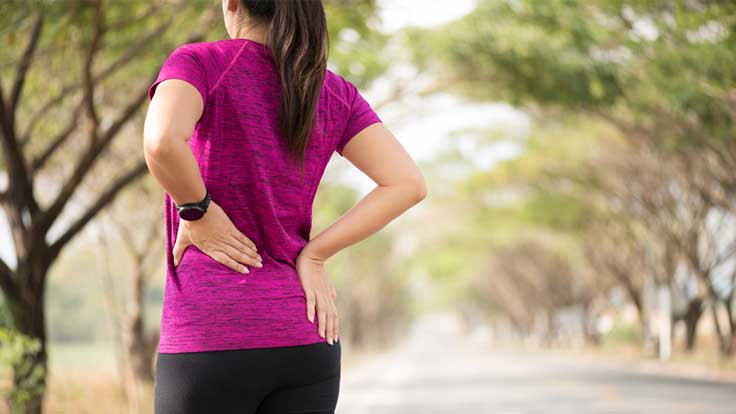A physical ailment is a disease or a condition that manifests itself with physical characteristics - often pain. Besides microbes, medication, and external stimuli, sometimes the causative factor for a physical ailment comes from the patient.
Back pain is one of the most common physical ailments. Studies show that around 80% of the world’s population suffers from back pain with a further 30% of the global population suffering from chronic back pain.
Reports estimate that around eight in ten Americans have had back pain at some point in their lives, mostly lower back pain. The ailment cannot be attributed to a single cause; factors such as age, posture, and injuries contribute to back pain.
Naturally Relieving Lower Back Pain
People tend to believe that there’s medication available for nearly every ailment. While there are muscle relaxants and pain-relieving medications for back pain, physicians are often wary of prescribing medication to their patients.
Why? Muscle relaxants can be highly addictive. Back pain is a condition that is caused by the natural aging process, posture, and unconsumed activity. The likelihood of the pain recurring is fairly high.
Popping a pill each time your back hurts leads to a dependency on muscle relaxants or pain medication. Natural remedies are therefore often sought out to limit the pain.
Natural remedies encompass a range of therapeutic treatments that do not involve drugs as their mainstay. The word ‘natural’ has often been used in conjunction with the kitchen or the garden but it actually involves any form of treatment that doesn’t involve medication.
Muscle Loosening Exercises For Back Pain Relief
Contrary to popular belief, people with back pain aren’t restricted in terms of movement. You can follow a regular exercise regimen whilst having back pain. Admittedly, certain exercises need to be avoided. These include exercises that put an unnecessary strain on your back.
The right kind of movement could be considered as physical therapy; manipulating the muscles to relieve pain. Exercising daily with brisk walks can help build stronger and more flexible muscles that are less prone to injury.
Consult a physical therapist for the best kind of exercise regimen to follow. A typical program for back pain relief as well as preventing problems in the future and improving function include all three major forms of exercise: aerobic activity, strength training, and flexibility exercises.
Avoid exercises that add stress to your spine, such as toe-touches and sit-ups. Also avoid those that include using your core muscles to build other muscles, such as leg raises. These exercises can be too demanding, causing fatigue and myalgia instead of relieving pain.
Partial crunches are often advised to strengthen your core. Wall-sits, knee tucks, and pelvic tilts also help in improving back function without putting any undue stress on your body.
Anti-Inflammatory Drinks For Lumbar Spine Pain
An anti-inflammatory drink is a drink consisting of ingredients that help relieve the tell-tale sign of pain i.e inflammation. Inflammation is, ironically so, your body’s way of defending itself against a stimulus that might harm it further.
The process has five cardinal signs: swelling, redness, heat, pain, and loss of function. All signs are concurrent with signs and symptoms of lower back pain. However, it is important to understand that inflammation alerts your body to a much more grave underlying issue.
Notwithstanding the obvious benefits of inflammation, sometimes the body’s natural process takes over any form of treatment. The severity of the inflammatory process overcomes treatment modalities.
In this case, nothing seems to be working, yet the body is in constant pain. This is where physicians recommend anti-inflammatory medication. In the case of lower back pain, however, medication is counterintuitive since it can lead to dependencies.
An anti-inflammatory drink contains natural ingredients that do not cause any form of addiction or dependencies. Some examples include:
Turmeric Milk:
Often also referred to as ‘golden’ milk, turmeric is an Asian spice believed to have antioxidant capacities and can be used as an anti-arthritic and anti-inflammatory substance.
Mix about half a teaspoon of turmeric powder into a warm glass of milk. The spice is often too much to handle for some people, in which case you can add honey or sugar substitutes to sweeten the drink.
Milk might cause an adverse inflammatory reaction in certain populations. It is important to recall your dietary evaluations before using turmeric milk to aid an ailment. For best results, drink golden milk at night.
Ginger-Green Tea:
Herbal-infused drinks have been used for centuries to cure ailments and conditions that trumped human comprehension. At that time, however, people worked based on trial and error.
Trial and error eventually led to the discovery of ginger-green tea as an anti-inflammatory herbal drink. Today, manufacturers supply this drink in tea bags, ready-made sachets, and such.
Over a while, these anti-inflammatory agents can build up in your bloodstream, so including these drinks in your daily diet will help reduce overall inflammation and prevent new inflammatory pain.
Cherry Drink:
Cherries contain a range of antioxidants and anti-inflammatory ingredients. Drinking a tall glass of tart cherry juice can help in relieving chronic pain if consumed daily.
This drink, like the ones mentioned above, is readily supplied in grocery stores.
How to Relieve Lower Back Pain With Hot and Cold Treatments
Hot and cold treatments are used to stimulate the muscles and relieve back pain, mostly those caused by injuries or accumulative stress on your back. These treatments usually work by reducing swelling and numbing the area of the pain.
These treatments are cost-effective and easy to implement. Hot or cold packs are one-time investments. However, whether you use a hot pack or a cold pack to alleviate pain is dictated by the type of pain.
If you want to relieve muscle soreness and acute pain, use cold packs. To relieve sub-acute or chronic pain, use hot packs. The pack alleviates pain by numbing the area and manipulating your muscles to release all kinds of endorphins.
A hot pack in particular stimulates blood flow to the area of an injury. It is best to use a hot pack around 48 hours after injury.
Avoid Extended Bed Rests
Bed rests used to be the mainstay in alleviating symptoms of pain but not necessarily for back pain. However, physicians now believe that an extended bed rest can further aggravate chronic back pain.
Lying still in one position for an extended period can put undue strain on your muscles. The extent of the injury is then felt once you try getting up. This puts patients in a vicious loop.
Avoid Smoking
There are a plethora of reasons why you should avoid smoking. Most of these reasons are pretty obvious, such as lung cancer. However, reports show that smokers have a four-time increased likelihood of developing degenerative disk disorders compared to non-smokers.
Maintain a Healthy Weight
A healthy weight dictated by your body’s fat percentage can help in determining the undue mechanical strain that you’re putting onto your body. Ideally, you should maintain a healthy weight for several reasons; alleviating back pain is on that list.
When to Consult a Doctor
If you begin to feel pain in your back that isn't subdued by massaging the area or with rest, you should consult a doctor. Associate the pain with your age, what you had been doing that day, and whether or not this pain is recurrent.
Your doctor will assess the pain using physical tests and determine the severity (in case of disc disorders) with radiation modalities. Once determined, they can then advise natural therapy before suggesting medications and eventually surgery.












